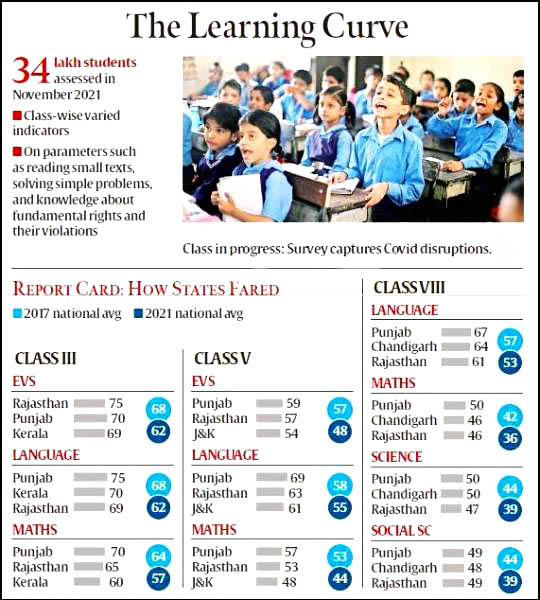Governance
National Achievement Survey (NAS)-2021
- 27 May 2022
- 7 min read
For Prelims: National Achievement Survey (NAS)-2021, Schedule caste, Scheduled Tribe, Part IV of Indian Constitution, Article 45, Article 39 (f), Directive Principles of State Policy (DPSP), RTE) Act, 2009, 42nd Amendment, 86th Amendment in 2002, Article 21-A
For Mains: Education, Government Policies & Interventions
Why in News?
Recently, the Ministry of Education released the National Achievement Survey (NAS) 2021 report.
- The Triennial Survey was conducted in November 2021.
- About 34 lakh students of 1.18 lakh schools in 720 districts from both rural and urban areas have participated in NAS 2021.
What is the National Achievement Survey (NAS)-2021?
- About:
- It is a nationwide survey to assess the learning outcomes and health of the education system.
- It is the largest, nationwide, sample-based education survey conducted across India.
- It is undertaken by the Ministry of Education.
- The Central Board of Secondary Education (CBSE) conducted NAS 2021.
- The National Council of Educational Research and Training (NCERT) designed an assessment framework and tools for NAS-2021.
- It provides a system-level reflection on the effectiveness of school education.
- It collects information on relevant background variables such as school environment, teaching processes, and student home and background factors.
- It covers the whole spectrum of schools including Government schools (both State and Central government), Government-aided schools, and Private schools across India.
- It is a nationwide survey to assess the learning outcomes and health of the education system.
- Medium and Grades:
- The NAS 2021 was conducted in 22 mediums of instruction that covered English, Assamese, Bengali, Gujarati, Kannada, Hindi, Malayalam, Marathi, Manipuri, Mizo, Punjabi, Odia, Telugu, Tamil, Bodo, Urdu, Garo, Konkani, Khasi, Bhutia, Nepali, and Lepcha.
- It was conducted in different subjects for different grades. The subject and grades wise break up is below:
- Grade 3 and 5: Language, EVS, and Mathematics
- Grade 8: Language, Science, Mathematics, and Social Science
- Grade 10: Language, Science, Mathematics, Social Science, and English
- Objective:
- To evaluate children's progress and learning competencies as an indicator of the efficiency of the education system, so as to take appropriate steps for remedial actions at different levels.
- Significance:
- It will help to unravel the gaps in learning and will support state/UT governments in developing long term, mid-term and short-term interventions to improve learning levels and orient on differential planning based on NAS 2021 data.
- The findings of NAS 2021 will help in diagnosing a systematic understanding of the consequences that prolonged closure of schools has had on the learning of students in terms of their socio-emotional and cognitive development.
- NAS findings will help in capacity building for teachers, officials involved in the delivery of education.
What are the Key Highlights of the NAS 2021?
- National Average:
- The national average percentage of students for class third was 59%, which declined by 10% to 49% in class fifth.
- It further declined to 41.9% in class eight and then 37.8% in class 10.
- The performance recorded a decline in almost all subjects.
- For instance, the mathematics score nationally was 57% in class third, dropping by almost 10% to 44% in fifth, and to 36% in class eighth, and 32% in class 10th.
- The language score nationally was 62% in class third, and dropped to 52% in class fifth, and to 53% in class eighth.
- For science, the national score declined from 39% in class eighth to 35% in class 10.
- Rural and Urban Areas:
- The average performance of schools in rural areas remained “significantly below” those urban areas in same states and union territories (UTs).
- Social-Group Wise Performance:
- The performance of students from the schedule caste (SC)/ schedule tribe (ST)/ Other Backward Classes (OBC) categories remained lower than that of students from the general category.
- Gender-wise Performance:
- The average performance of girls remained better than the boys in almost all subjects across the classes, both nationally and at state level.
- Perception of Students about Learning:
- The perception of students about learning at home during the pandemic when the schools remained closed, and 78% of students termed it as burdensome with a lot of assignments.
- At least 38% of students faced difficulties in learning at home, while 24% said they did not have digital devices at home.
How did the States Perform?
- The majority of the states performed significantly below the overall national score, some states such as Kerala, Rajasthan, Maharashtra and Punjab performed better than the national average.
- Delhi’s performance in class eighth and class 10 was better when compared with the national average.
- Punjab has scored highest in all subjects for classes 3, 5 and 8.
What is the Status of Education in India?
- Constitutional Provisions:
- Part IV of Indian Constitution, Article 45 and Article 39 (f) of Directive Principles of State Policy (DPSP), has a provision for state-funded as well as equitable and accessible education.
- The 42nd Amendment to the Constitution in 1976 moved education from the State to the Concurrent List.
- The 86th Amendment in 2002 made education an enforceable right under Article 21-A.
- Related Laws:
- Right To Education (RTE) Act, 2009 aims to provide primary education to all children aged 6 to 14 years and enforces education as a Fundamental Right.
- It also mandates 25% reservation for disadvantaged sections of the society.
- Right To Education (RTE) Act, 2009 aims to provide primary education to all children aged 6 to 14 years and enforces education as a Fundamental Right.
- Government Initiatives:







